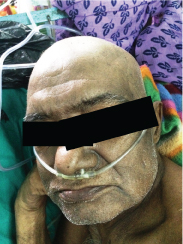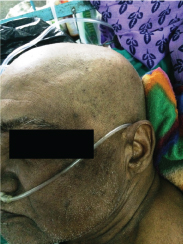Polymyxin B is a polypeptide-antibiotic, primarily used for resistant Gram-negative infections, first obtained from bacterium Bacillus polymyxa in the late 1940s. Antibiotic spectrum are restricted to mainly gram negative bacterias like Enterobacter, E. coli, Klebsiella, Salmonella, Pasteurella, Bordetella, Shigella; and particularly organisms like Pseudomonas aeruginosa and Acinetobacter baumannii, which are extremely potent to acquire antibiotic resistance. Side effects include neurotoxicity and acute renal tubular necrosis.
Here, we present a rare case of skin hyper-pigmentation in a 65-year-old elderly male of Indian origin, diagnosed as a case of Multi-Drug Resistant (MDR) Klebsiella pneumonia, treated with intravenous antibiotics. The manifestations were observed after 4 days of Polymyxin B therapy initiation. All other concomitant drugs, infections, or immunologic disorders that, could have caused this symptom, were carefully excluded. An objective causality assessment reveals that, the cutaneous hyperpigmentation was possibly associated with Polymyxin B therapy, though further studies may be needed to explain the underlying mechanism.
Drug reaction,Klebsiella,Multidrug resistant
Case Report
We present a rare case of Polymyxin B-induced diffused cutaneous skin hyperpigmentation in a 65-year-old elderly male of Indian origin. This patient had initially presented in the emergency with shortness of breath and low grade intermittent fever for last three months. He was also suffering from persistent productive cough and occasional haemoptysis for same duration. He was a known case of Chronic Obstructive Pulmonary Disease (COPD) for last 3 years and was on oral and inhalational medications.
No past history of tuberculosis, significant weight loss, malignancy or cardiac disease could be elicited. Patient was non-smoker, non-alcoholic with no known history of any drug abuse. He was provisionally diagnosed to be in a state of acute exacerbation of COPD with left lower lung pneumonic consolidation and right-sided small pneumothorax.
Laboratory investigations revealed: haemoglobin 12.7g/dl, Total Leukocyte Count (TLC) 10,400 with neutrophils 85%, lymphocyte 12%, random plasma glucose levels 156mg/dl, creatinine 0.6mg/dl, bilirubin 0.9mg/dl, ALT 45IU. Arterial blood gas report showed: pH(7.43), pCO2(49.3), pO2(62.6), HCO3(32.5), SpO2(86%) (room air), Na+ (130), K+ (4). Echocardiogram suggested good preserved ventricular systolic function (ejection fraction 56%) with no regional wall motion abnormality, grade-I diastolic dysfunction with mild tricuspid regurgitation. Chest skiagram showed a thick walled cavity on left side, basal consolidations and increased peri-hilar translucency; sputum was negative for Acid Fast Bacilli (AFB) and Cartridge Based Nucleic Acid Amplification Test (CBNAAT) excluding pulmonary tuberculosis.
On examination, blood pressure was 100/70mmHg, pulse rate 110/min, JVP not raised, trachea shifted to left, poor bilateral air entry into lungs and bilateral severe wheeze.
Patient was initially started on Fixed Dose Combination (FDC) of Piperacillin-Tazobactum (4.5gm intravenous thrice daily) and later upgraded to Meropenem (1gm thrice daily). Concurrent nebulization with Levo-Salbutamol (2 inhalations; 90mcg 6 hourly) and Ipratropium Bromide (2 inhalations; 36mcg 6 hourly), intravenous injection hydrocortisone (2mg/kg 6 hourly) were also initiated to maintain desired pO2 and SpO2.
Subsequent sputum culture-sensitivity report revealed Multidrug-Resistant (MDR) Kleibsiella pneumoniae, hence, intravenous Polymixin B (500,000IU 12 hourly) was initiated immediately. Four days later, diffuse cutaneous hyperpigmentation was observed, confined to scalp, face and area around neck as depicted in [Table/Fig-1 and 2]. Despite such event, same treatment was continued after specialist pulmonolgy consultation, as the patient was steadily improving. The patient received a 2 week course of Polymyxin B, and was later discharged in a haemodynamically stable condition.
Head and facial hyper-pigmentation after Polymyxin B therapy.

Cutaneous hyper-pigmentation over scalp, face and adjoining neck areas.

Skin biopsy could not be performed, so exact mechanism of skin darkening could not be defined.
Discussion
Polymyxins are polypeptide-antibiotic, which were first derived from different species of Bacillus polymyxa in 1947, and were commercially available from 1959 [1]. They constitute a chemically diverse class with 5 different chemical moieties, namely Polymyxin A, B, C, D and E; among which only Polymyxin A and E (Colistin) are used clinically in practice [2]. Polymyxin B is composed of polymyxins B1, B1-I, B2, B3, and B6. Polymyxins B1 and B2 are considered major components [3]. These related components are structurally identical with the exception of a variable fatty acid group on each fraction [4].
Polymyxins are cationic detergent molecules with a simple basic peptide structure. Antibiotic spectrum are restricted to mainly Gram negative bacterias like Enterobacter, E. coli, Klebsiella, Salmonella, Pasteurella, Bordetella, Shigella; particularly to organisms like Pseudomonas aeruginosa and Acinetobacter baumannii, which either have a high-level intrinsic resistance to many antibiotics or are extremely potent to acquire antibiotic resistance [5]. These antibiotics work mainly by altering bacterial outer membrane permeability, by binding to a negatively charged site in the lipopolysaccharide layer, which has an electrostatic attraction for the positively charged amino groups in the cyclic peptide portion, thereby, destabilizing the outer membrane. Moreover, the fatty acid portion of the structure dissolves in hydrophobic region of cytoplasmic membrane, further disrupting bacterial membrane integrity, causing leakage of cellular molecules, inhibition of cellular respiration and endotoxin neutralization [6]. Most commonly noted toxicities are nephrotoxicity and neurotoxicity, while some minor documented adverse reactions are fever, eosinophilia and macular and urticarial rashes [7].
Of late, there has been resurgence in the systemic use of Polymyxin group of antibiotics, mainly due to emergence of MDR Gram-negative organisms. As with our patient, Polymyxin B was administered only after culture sensitivity report revealed existence of a MDR Kleibsiella pneumonia airway infection. Despite serious adverse effects like neurotoxicity and nephrotoxicity, reports of skin hyperpigmentation in adults with Polymyxin B is rare, unlike in infant or pediatric age group [1,8,9]. Exact mechanism of such cutaneous hyper-pigmentations is still not clear. Since, skin-tone depends mainly on eumelanin, a possible mechanism could be via augmented melanogenesis by inflammatory mediators as histamine which may be released by Polymyxin B [10]. Polymyxin B is mainly excreted by renal route and recommended daily dosing is 15-25000IU/kg/day in divided doses, hence, requires dose alteration in patients with lower creatinine-clearance (chronic kidney disease) [2].
The patient was receiving various concomitant drugs as mentioned earlier, but skin hyper pigmentation was evident only after few days of initiating Polymyxin B. Naranjo Adverse Drug Reaction Probability Scale suggests, Polymyxin B was probably associated with the skin hyperpigmentation here (+2 for adverse event occurring after drug administration, +1 for confirmed by objective evidence, +2 for absence of possible alternative cause = 5 points) [11].
Conclusion
In this case the patient was receiving normal doses and skin hyperpigmentation was not likely to be dose dependent. Skin discoloration was limited to only face and neck only. Since, all other causes like concomitant drugs, infections, or immunologic disorders that could have caused this symptom, were carefully excluded, an objective causality assessment reveals that the cutaneous hyperpigmentation was possibly associated with Polymyxin B therapy, though, further studies may be needed to explain the underlying mechanism.
[1]. Shih LK, Gaik CL, Polymyxin B induced generalized skin hyperpigmentation in infants Journal of Pediatric Sciences 2014 6:e215 [Google Scholar]
[2]. Falagas ME, Kasiakou SK, Toxicity of polymyxins: a systematic review of the evidence from old and recent studies Critical Care 2006 10(1):R27 [Google Scholar]
[3]. Kim KS, Kim T, Pan JG, In vitro evaluation of ciclopirox as an adjuvant for polymyxin B against gram-negative bacteria Journal of Antibiotics 2015 68(6):395 [Google Scholar]
[4]. Tsubery H, Ofek I, Cohen S, Fridkin M, Structure-function studies of Polymyxin B Non-apeptide: Implications to sensitization of Gram-negative bacteria Journal of Medicinal Chemistry 2000 43(16):3085-92. [Google Scholar]
[5]. Zavascki AP, Goldani LZ, Li J, Roger L, Nation. Polymyxin B for the treatment of multidrug-resistant pathogens: a critical review Journal of Antimicrobial Chemotherapy 2007 60:1206-15. [Google Scholar]
[6]. Thomas CJ, Surolia N, Surolia A, Surface plasmon resonance studies resolve the enigmatic endotoxin neutralizing activity of polymyxin B Journal of Biological Chemistry 1999 274(42):29624-27. [Google Scholar]
[7]. Landman D, Georgescu C, Martin DA, Quale J, Polymyxin Revisited Clin Microbiol Rev 2008 21:449-65. [Google Scholar]
[8]. Gothwal S, Meena K, Sharma SD, Polymyxin B induced generalized hyperpigmentation in neonates Indian J Pediatr 2016 83(2):179-80. [Google Scholar]
[9]. Zavascki AP, Manfro RC, Maciel RA, Falci DR, Head and neck hyperpigmentation probably associated with polymyxin B therapy Annals of pharmacotherapy 2015 49(10):1171-72. [Google Scholar]
[10]. Bushby SRM, Green AF, The release of histamine by Polymyxin B and Polymyxin E Brit J Pharnacol 1955 10:215-12. [Google Scholar]
[11]. Naranjo CA, Busto U, Sellers EM, Sandor P, Ruiz I, Roberts EA, A method for estimating the probability of adverse drug reactions Clin Pharmacol Ther 1981 30:239-45. [Google Scholar]